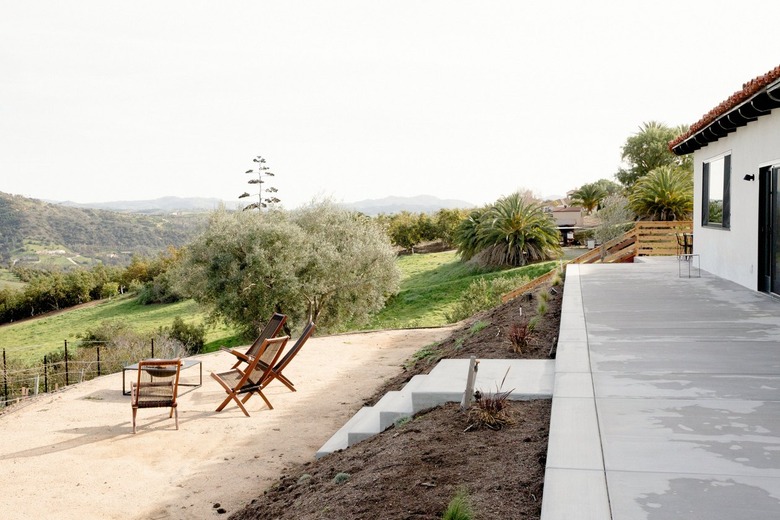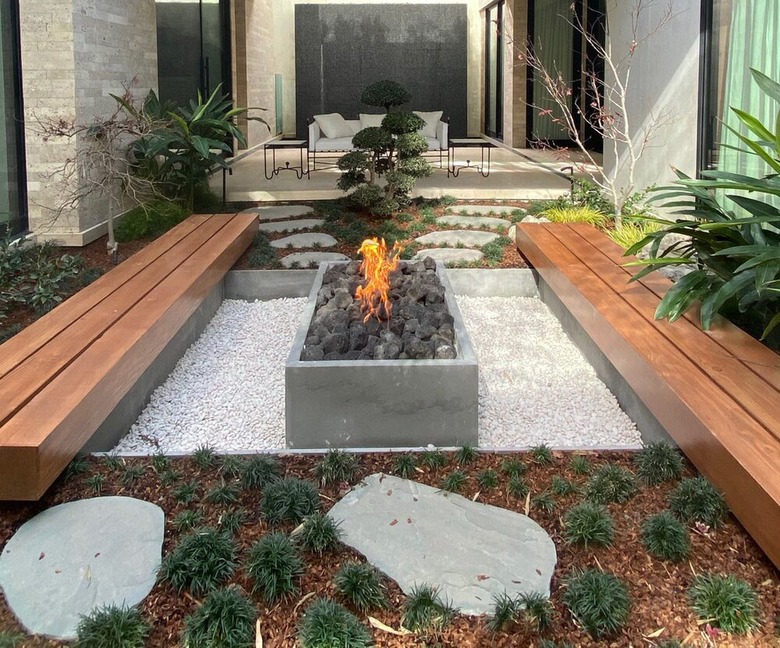What To Know Before You Hire A Landscape Designer
One morning you look at the crowded shrubs and the overgrown daisies in your backyard and realize that the plants you picked piecemeal from the garden store just aren't working well in your space. It may be time to bring in a landscape designer or a landscape architect — someone who knows how to create a landscape.
Landscape designers don't just put in some trendy annuals. They propose design options that will make your space beautiful and exciting, from meandering pathways to flowering hedges and outdoor fountains to rose gardens. Landscape architects are professionals with advanced training to tackle larger landscapes and to suggest more complex design structures.
Ready to take your garden from so-so to stunning? Here's everything you need to know about hiring a landscape designer.
What Landscape Designers Do
Landscape designers look at your property with an overview in mind. They assist you to map out a design vision for your outdoor areas that fits your taste as well as your budget, taking into account the climate of your area and the exposure of your yard.
Landscape professionals are designers first and foremost. They aren't there to cut your lawn but rather to help you figure out whether a lawn is the best use of your space. They assess the property as is, identifying both the problem areas and the exciting possibilities and then propose a design overview that works with your sensibilities and the style of the neighborhood. Once they address the big picture, they get down to the details, proposing the best materials, colors, styles, and textures for the project.
The particular services depend on the project and the design firm, but they can include:
- Preparing an overall design for the outdoor space that unifies the property and
extends your
living space. - Proposing a design that incorporates outdoor hardscape features, like fire pits, patios, fountains, and arbors. Even boulders can be an attractive landscape addition. The idea is to make an inviting natural space that is also environmentally sustainable.
- Suggesting specific placement for trees and large shrubs that can lower your heating and cooling costs while enhancing the landscape. They will also know what trees to avoid and which trees work well in your ecosystem.
- Creating
low-maintenance gardens that work with your climate, including tough perennials, native plants, and other drought-resistant plants, like succulents that need little water yet attract pollinators to your garden. - Ensuring that there is sufficient room for the plants to mature in the way suggested by their normal growth patterns, factoring in seasonal changes. A backyard should be attractive in all four seasons.
- Designing built-in drip irrigation systems that provide just the water needed without water waste or overwatering issues.
- Overseeing plant selection, purchase, and installation. While some designers only undertake the design
process, offering a master plan for your garden, others also build the gardens they create on paper. Designers who are also registered contractors may obtain permits and
install hardscaping, like decks and deck lighting. If not, they may work with landscapers and contractors to get the job done. - Providing ongoing landscape maintenance. It is possible to find landscape designers who
will oversee ongoing garden maintenance in addition to designing and installing the landscape. - Managing the terrain. Landscape contractors regularly evaluate backyard terrain and understand how it will impact the
design and construction of hardscaping features. Some have experience working with more complex terrain, like marshlands or woodlands.
Doing Your Homework
Before picking up the phone to talk to a landscape designer or landscaping architect, spend some time evaluating your needs, wants, and budget. Read up about basic landscape design and jot down a few ideas. While a designer specializes in providing an overview of garden renovation, you'll work more efficiently as a team if you have an idea of the type of space you want, the amount of maintenance you are willing to undertake on a continuing basis, and what parts of the plan you want to do yourself.
You'll also need to decide in advance what services you want from the designer. Some homeowners only want professional design help, and others want a designer who will undertake the actual landscaping project.
Landscape Designer vs. Landscape Architect
When you decide to bring in help to revamp your landscape design, there are several types of specialists you can consider. It's important to have done your homework first and determined the scope of the help you need before deciding whether a landscape designer or a landscape architect makes the most sense for your project. These professionals undertake similar roles in outdoor projects, but there are key differences in education and specialization.
Landscape designers are usually self-taught and acquire their skills through hands-on work or on-the-job training. Although they may hold undergraduate degrees, this is not required. Their focus is designing landscapes and gardens for homes. They will have skills in general yard maintenance; soil analysis; types of plants — including landscape trees — and their cultural requirements; and color, texture, and proportion for gardens. They will also have basic knowledge about drainage and structural design.
Many (if not most) designers are designer/builders, putting together a plan that they then install in your backyard. Their services are less expensive than those of the landscape architect and may be the better option for homeowners looking to revamp their gardens rather than design an estate.
A landscape architect, on the other hand, is a trained architect, typically holding a degree in landscape architecture. They must take exams and earn state certification in order to practice their profession. Architects will have more skills when it comes to complex concepts, like environmental impact of landscape features, advanced structural design, requirements of permitting, biome considerations in protected areas, energy efficiency, and water management. They typically draft more blueprints and reports than designers to provide direction for those installing the project.
Landscape architects do not do the building work themselves. These professionals have expertise in commercial and industrial architectural concepts that makes them the better choice to design large, private estates or public spaces, such as parks and commercial centers. Consider them for a home project if you are facing a specific problem, like living in a flood zone.
However, it's important to not confuse either of these designers with a landscaper. This is a term used for the contractors who do the actual work (the digging, planting, etc.). These are contractors who work with designers and architects to carry out their design plans. They may also maintain landscapes. Some landscapers move into landscape design after acquiring sufficient experience.
Questions to Ask a Landscape Designer Before Hiring
Before you pick up the phone to interview landscape designers, it pays to have a list of questions ready. These will be useful to both you and the designer, helping to identify designers who will work well with your project.
1. What Services Do You Offer?
Do they limit their services to helping put together a master design for your landscape, or are they a designer/builder who create the design and also oversee plant purchase and installation? Are they qualified to get permits and install hardscaping? Then, figure out what you can do yourself. Do you want to be involved in creating the master plan?
Getting a designer whose style matches your dream landscape is very helpful. Ask to see photos of gardens they have designed and find out about their training, including any degrees from accredited landscape design colleges.
Ask if the designer will come to look at your current garden and talk with you about your ideas for remodeling it. It's an opportunity to see if you get along easily and to ask for their initial ideas about how to create your best landscape. This should take a few hours, and you'll have to pay for it, but the information you glean can go a long way toward helping you select the right person.
Budget issues must be addressed and considered up front. A straightforward discussion of how much the designer charges and how much you can budget for the project is essential. Most designers will estimate the cost based on the size of the landscape and the type of landscaping that is included. Given the many alterations that occur between design and installation, ask about change fees and how she bills for changes in the scope of the project. At the same time, discuss ways to reduce the cost of the landscape so that it can fit your budget.
Ask the designer how much time it will take to design and install your landscape. That will of course depend on the size and scope of the project among other factors. The best you can hope for is a realistic range of time for the project to be completed.
How many hours a day or week will you have to invest to keep your yard looking nice? Putting in a garden is one thing; maintaining it is another. Don't hesitate to set out how much yard maintenance you are willing to undertake since there are low-maintenance options out there, including xeriscaping with native plants. If the garden you want requires more maintenance time than you want to invest, ask your landscape designer if they can recommend landscapers to take care of the garden going forward.
The Cost of Hiring a Landscape Designer
How landscape designers typically bill for their work varies by region and market. Landscape designers often charge by the hour for consultations but may offer a flat rate bid for the garden design itself. The average cost for a landscape design is $4,480, with a typical range from $1,957 to $7,011. Architects may charge $6,000 or more for a plan. Costs for designers and architects vary depending on the complexity of the plan. For simple plans, it is possible to save money by getting a short, on-site consultation without a written plan.
Designers charge between $50 and $200 an hour for consultations, and you'll want to find out the exact amount before you bring them out for the initial visit. Most charge between $50 and $75 an hour. "Big name" designers are on the high end.
Flat project rates may be based on a calculation of the number of hours the designer will need to put into the project. They may also offer flat rates based on the size of the landscape, perhaps $2,000 for an acre. In urban areas where yard sizes are uniform, there may be flat rates for front yards and another flat rate for backyards. A flat rate may include a limited number of plan revisions, but it usually doesn't include time spent working with landscapers. Design plan pricing ranges widely from $300 to over $15,000, though most bids come in at under $6,000.
Landscape Designer/Architect Licensing and/or Certification
The work of a landscape architect and a landscape designer will overlap, but there are very different education and licensing requirements for these professions. Landscape designers are not required to have any formal education, though some hold relevant degrees, such as in horticulture. No licensing or certification is required unless the designer also holds a contractors' license.
A landscape architect must be a trained architect and usually holds a degree or degrees in landscape architecture. They must earn state certification by passing landscape architect exams. Often, continuing education is also required.
References
- HomeAdvisor: How Much Does A Landscape Designer Charge?
- American Society of Landscape Architects: 10 Reasons to Hire a Landscape Architect
- Angi: How Much Does Hiring a Landscape Designer Cost?
- Indeed: Landscape Architect vs. Landscape Designer: What's the Difference?
- Million Acres: When Should I Hire a Landscape Architect?


